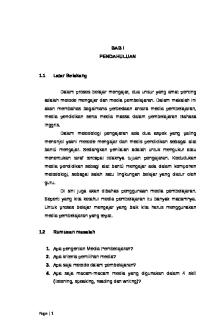MODUL - BAHASA INGGRIS - FAKULTAS TEKNIK PDF

| Title | MODUL - BAHASA INGGRIS - FAKULTAS TEKNIK |
|---|---|
| Author | No Name (secret) |
| Pages | 45 |
| File Size | 1.6 MB |
| File Type | |
| Total Downloads | 44 |
| Total Views | 284 |
Summary
Sentences and clauses Sentences and clauses Simple sentences I. Simple sentences consist of one clause. Ann went to the bank. She withdrew £100. Two or more clauses can be joined to make a compound sentence or a complex sentence. II. Compound sentences A compound sentence is one that consists of...
Description
Sentences and clauses
Sentences and clauses Simple sentences I. Simple sentences consist of one clause.
Ann went to the bank.
She withdrew £100.
Two or more clauses can be joined to make a compound sentence or a complex sentence.
II. Compound sentences A compound sentence is one that consists of two main clauses, joined by a word such as and, but, or or, called a coordinating conjunction. Each clause is of equal importance and gives information of equal value. The order of the clauses can be very important for the meaning. For example, the timing of an action can be described by the order in which the clauses follow each other.
He picked it up and ran over to her.
He ran over to her and picked it up.
I drove to Coatbridge and went on to Stirling.
III . Complex sentences Complex sentences are those that contain a subordinate clause as well as a main clause.
When he arrives, I’ll phone you.
He stayed at home because he felt ill.
A subordinate clause is one that contains special information about the main clause. It will usually be introduced by a linking wordsuch as when, if, because, or that. The linking words are called subordinating conjunctions.Most subordinate clauses can come before, after, or within the main clause. Usually, when one clause is of principal importance and the other clause gives
information about the principal one, we have a complex sentence with one main clause and one subordinate clause. The position that a subordinate clause is placed in is determined largely by what is felt to be the main message of a sentence.
Since you seem to have made up your mind, I’ll say no more.
I stopped seeing her because she moved to Liverpool.
IV. Compound-complex sentences These have more than one main clause and at least one subordinate clause.
Angie came over and we decided to use my car because hers was playing up.
He ran over to Julie, who was sitting at the end of the bench, and grabbed her handbag.
TUGAS : CONTOH SIMPLE SENTENCES 1.Our flight delayed an hour 2. She is the most beautiful in the class 3. Dad go to hospital once in two months 4. My phone is missing 5. I can't see the text on whiteboard clearly 6. I go to gym every wednesday 7. Lisa moved to Bogor since 3 month ago 8. Aurora no longer worked in that office 9. I wake up on 6 a.m every morning 10. I love her smile
READING COMPREHESION
Comprehension: The Goal of Reading Comprehension, or extracting meaning from what you read, is the ultimate goal of reading. Experienced readers take this for granted and may not appreciate the reading comprehension skills required. The process of comprehension is both interactive and strategic. Rather than passively reading text, readers must analyze it, internalize it and make it their own. In order to read with comprehension, developing readers must be able to read with some proficiency and then receive explicit instruction in reading comprehension strategies (Tierney, 1982). General Strategies for Reading Comprehension The process of comprehending text begins before children can read, when someone reads a picture book to them. They listen to the words, see the pictures in the book, and may start to associate the words on the page with the words they are hearing and the ideas they represent. In order to learn comprehension strategies, students need modeling, practice, and feedback. The key comprehension strategies are described below. Using Prior Knowledge/Previewing When students preview text, they tap into what they already know that will help them to understand the text they are about to read. This provides a framework for any new information they read. Predicting When students make predictions about the text they are about to read, it sets up expectations based on their prior knowledge about similar topics. As they read, they may mentally revise their prediction as they gain more information. Identifying the Main Idea and Summarization
Identifying the main idea and summarizing requires that students determine what is important and then put it in their own words. Implicit in this process is trying to understand the author‟s purpose in writing the text.
Questioning Asking and answering questions about text is another strategy that helps students focus on the meaning of text. Teachers can help by modeling both the process of asking good questions and strategies for finding the answers in the text. Making Inferences In order to make inferences about something that is not explicitly stated in the text, students must learn to draw on prior knowledge and recognize clues in the text itself. Visualizing Studies have shown that students who visualize while reading have better recall than those who do not (Pressley, 1977). Readers can take advantage of illustrations that are embedded in the text or create their own mental images or drawings when reading text without illustrations. Strategies for Reading Comprehension: Narrative Text Narrative text tells a story, either a true story or a fictional story. There are a number of strategies that will help students understand narrative text. Story Maps Teachers can have students diagram the story grammar of the text to raise their awareness of the elements the author uses to construct the story. Story grammar includes:
Setting: When and where the story takes place (which can change over the course of the story).
Characters: The people or animals in the story, including the protagonist (main character), whose motivations and actions drive the story.
Plot: The story line, which typically includes one or more problems or conflicts that the protagonist must address and ultimately resolve.
Theme: The overriding lesson or main idea that the author wants readers to glean from the story. It could be explicitly stated as in Aesop‟s Fables or inferred by the reader (more common).
Retelling Asking students to retell a story in their own words forces them to analyze the content to determine what is important. Teachers can encourage students to go beyond literally recounting the story to drawing their own conclusions about it. Prediction Teachers can ask readers to make a prediction about a story based on the title and any other clues that are available, such as illustrations. Teachers can later ask students to find text that supports or contradicts their predictions. Answering Comprehension Questions Asking students different types of questions requires that they find the answers in different ways, for example, by finding literal answers in the text itself or by drawing on prior knowledge and then inferring answers based on clues in the text. Strategies for Reading Comprehension: Expository Text Expository text explains facts and concepts in order to inform, persuade, or explain. The Structure of Expository Text Expository text is typically structured with visual cues such as headings and subheadings that provide clear cues as to the structure of the information. The first sentence in a paragraph is also typically a topic sentence that clearly states what the paragraph is about. Expository text also often uses one of five common text structures as an organizing principle:
Cause and effect
Problem and solution
Compare and contrast
Description
Time order (sequence of events, actions, or steps)
Teaching these structures can help students recognize relationships between ideas and the overall intent of the text.
Main Idea/Summarization A summary briefly captures the main idea of the text and the key details that support the main idea. Students must understand the text in order to write a good summary that is more than a repetition of the text itself.
TUGAS Read the following text carefully and answer the questions.
Road rangers in the sky. (By Derek Brown) Airlines and their long-suffering customers are reporting a steep climb in air rage incidents. Some incidents are apparently caused by problems which are familiar to many regular travellers. One case reported from America stemmed from an interminable delay in takeoff, when passengers were cooped up in their aircraft on the tarmac for four hours, without food, drink or information. Mass unrest is less common then individual misbehaviour, as in the case of the convict who recently went crazy on a flight, attacked the crew and tried to open a door in mid-flight. The psychology of air rage is a new area of study, and there are almost as many explanations as examples. Most analysts of the phenomenon blame alcohol, but many people now think that the airlines are at fault. To cut cost, they are cramming ever more passengers into their aircraft, while reducing cabin crew, training and quality of service, all of which increase passenger frustration. In addition, there is increasing concern in the US about another cost-cutting exercise, which could seriously harm passengers' health: cabin ventilation. Modern aircraft are equipped with sophisticated air conditioning devices - but running them at optimum capacity burns up valuable aviation fuel. Many airlines routinely instruct their flight crews to run the systems on minimum settings. Campaigners for improved air quality claim that this can lead to irritability and disorientation. In the US, the soaring number of passenger complaints across a wide range of issues is reflected in a number of new Internet sites which criticize the airlines and demand better service. One of the sites is demanding an air passengers' Bill of Rights. Cabin and flight crews, who are in the front line of the battle against disruptive and dangerous in flight behaviour, have called for stiffer penalties against the offenders. Management have also called for legislation - while denying that its cost-cutting practices have contributed to the problem. But there are some signs, in the US at least, that the airlines are at last attempting to respond to customer dissatisfacation. Some major lines have announced concessions to the most frequent complaint of all, and are removing seats to make more room for their customers.
Question : A. Which of these statements are true about the article? Correct the false ones. 1. People in groups are more likely to behave badly on planes.
2. Drink is often the cause of problems on board. 3. Airlines can do little to improve air quality. 4. Travellers are using new technology to express their dissatisfaction with airlines. 5. Airlines have taken no action to address travellers' concerns.
Answer : Statement 1 : People in groups are more likely to behave badly on planes. That statement corresponds to the last sentence of the first paragraph that reads “Mass unrest is less common then individual misbehaviour, as in the case of the convict who recently went crazy on a flight, attacked the crew and tried to open a door in mid-flight”. So this statements is true. Statement 2 : Drink is often the cause of problems on board. “Most analysts of the phenomenon blame alcohol, but many people now think that the airlines are at fault.” That sentence explained the statement, that drink which means alcohol is often the cause of problems on board. Statement 3 : Airlines can do little to improve air quality. I think this statement is true because from the text we can know that Airlines can do little to improve air quality like Running air conditioning devices at optimum capacity or removing seats to make more room for customers. Statement 4 : Travellers are using new technology to express their dissatisfaction with airlines. This statement can make you confuse about what the meaning of “new technology”. From the text, we can read this sentences: “In the US, the soaring number of passenger complaints across a wide range of issues is reflected in a number of new Internet sites which criticize the airlines and demand better service.” If this “new Internet sites” can be interpreted as “ new Technology”, Statement 4 is true. Statement 5 : Airlines have taken no action to address travellers' concerns. I think this statement is wrong. Because from the text we know that in the US at least, that the airlines are at last attempting to respond to customer dissatisfacation. And they take action like have announced concessions to the most frequent complaint of all, and are removing seats to make more room for their customers. Statement 5 should be “Airlines have taken some action to address travellers' concerns.” From the explanation above, we can conclude that the answer is number 5. Because the statement 5 is wrong and the others is true.
Question : B. Which of the following reasons are given for air rage in the article? 1. poor service
6. people drinking alcohol
2. flights not leaving on time
7. poor air quality
3. poor quality of food
8. noisy passengers.
4. too many passengers on a plane
9. not being able to smoke
5. not feeling safe
10. not enough cabin crew
Answer : For this question, we can read the article carefully to conclude what causes air rage Sentence : One case reported from America stemmed from an interminable delay in takeoff, when passengers were cooped up in their aircraft on the tarmac for four hours, without food, drink or information. Explanation : from that sentence we know that one of the reasons is number 2. Flight not leaving on time Sentence : Most analysts of the phenomenon blame alcohol, but many people now think that the airlines are at fault. Explanation : from that sentence, we know that other reasons is number 1 and number 6. Number 1 is conclusion of sentence “but many people now think that the airlines are at fault” And number 6 is conclusion of sentence “most analyst of the phenomenon blame alcohol” Sentence : To cut cost, they are cramming ever more passengers into their aircraft, while reducing cabin crew, training and quality of service, all of which increase passenger frustration. Explanation : from that sentence, we can conclude that other reasons is number 4 and number 10. The sentence “reducing cabin crew, training and quality of service” beside explain number 10, explain number 1 too about poor quality of service. Sentences : Many airlines routinely instruct their flight crews to run the systems on minimum settings. Campaigners for improved air quality claim that this can lead to irritability and disorientation. Explanation : that sentence explain number 7 about poor air quality. Beside that sentence, we can conclude from this sentence too “In addition, there is increasing concern in the US about another costcutting exercise, which could seriously harm passengers' health: cabin ventilation.” So, From explanation above, we can conclude that the answer is number 1, 2, 4, 6, 7, and 10.
Question : C. Which of the following words from the article have a negative meaning? Use a good dictionary to help you. rage
misbehaviour
quality
frustration
concern
harm
optimum
valuable
irritability
disorientation
disruptive
dangerous
complaiants
critise
dissatisfaction
Answer : To Answer this question, we must know what the meaning of that words. Meaning in that single words, and meaning in this article. After that, we can know which words have negative meaning, and which ones that have positive meaning. Rage
: kemarahan, kegusaran, kekerasan
Concern
: perhatian, perihal
Irritability
: Sifat mudah marah, emosi
Disruptive
: mengacaukan, mengganggu
Misbehaviour : kelakuan buruk, kelakuan jahat Harm
: membahayakan, merugikan
Disorientation : hilang arah, bingung Dangerous
: berbahaya
Quality : kualitas example : poor quality, bad quality) Optimum
: Optimal
ve
Complaiants : Komplain, Kritik article we can conclude complaiant means negative because forms of customer anger and dissatisfaction) Dissatisfaction : Tidak puas, ketidakpuasan Frustation
: Frustasi, kesal
Valuable
: Bernilai, berharga
Critise : Mengkritik article we can conclude complaiant means negative because forms of customer anger and dissatisfaction)
From that explanation above, we can conclude thw words which have negative meaning are Rage, Irritability, Disruptive, Misbehaviour, Harm, Disorientation, Dangerous, Complaiants, Dissatisfaction, Frustation, and Critise. There is 11 words from 15, that have negative meaning.
Reading Comprehension Dirty Business, Bright Ideas By Gina Imperato 1. A headquarters with a difference Walk into SOL City, headquarters of one of northern Europe‟s most admired companies, and it feels like you‟ve entered a business playground. Located in a renovated film studio in the heart of Helsinki, the office explodes with colour, creativity and chaos. The walls are bright red, white and yellow; the employees wander the halls talking on yellow portable phones. Liisa Joronen developed SOL Cleaning Service 11 years ago, out of a 150-year-old industrial empire owned by her family. SOL‟s competitive formula has five key ingredients. 2. Hard work has to be fun Few people dream about becoming a cleaner. But that doesn‟t mean cleaners can‟t find satisfaction in their work. The keys to satisfaction, Joronen believes, are fun and individual freedom. Its cleaners wear red-and yellow jumpsuits that reinforce the company‟s upbeat image. SOL‟s logo, a yellow happy face, is on everything from her blazer to the company‟s budget reports. Freedom means abolishing all the rules and regulations of conventional corporate life. There are no titles or secretaries at SOL, no individual offices or set hours of work. The company has eliminated all perks and status symbols. 3. There are no low-skill jobs SOL‟s training programme consists of seven modules, each of which lasts four months and ends with a rigorous exam. Of course, there are a limited number of ways to polish a table or shampoo a carpet. That‟s why SOL employees also study time management, budgeting and people skills. 4. People set their own targets Lots of companies talk about decentralising responsibility and authority. At SOL it‟s a way of life. The real power players of the company are its 135 supervisors, each of whom leads a team of up to 50 cleaners. These supervisors work with their teams to create their own budgets, do their own hiring and negotiate their own deals with customers. 5. Loose organisations need tight systems Liisa Joronen believes in autonomy, but she‟s also keen on accountability. SOL is fanatical about measuring performance. It does so frequently and visibly, and focuses on customer satisfaction. Every time SOL lands a contract, for example, the salesperson works at the new customer‟s site alongside the team that will do the cleaning in the future. Together they establish performance benchmarks. Then, every month, the customer rates the team‟s performance based
on those benchmarks. „The more we free our people from rules,‟ Joronen says,‟the more we need good measurements.‟ 6. Great service requires cutting –edge technology Laptops and cell-phones are standard equipment for all supervisors at SOL, freeing them to work where they want, how they want. Inside the office there‟s almost no room for paper. So the company stores all critical budget documents and performance reports on its intranet, along with training schedules, upcoming events and company news.
<...
Similar Free PDFs

MODUL Bahasa Inggris XI smester
- 9 Pages

BAHASA INGGRIS
- 10 Pages
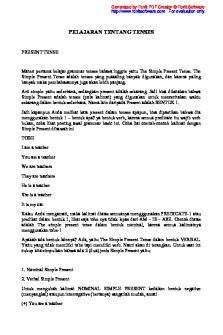
16 tenses bahasa inggris
- 27 Pages
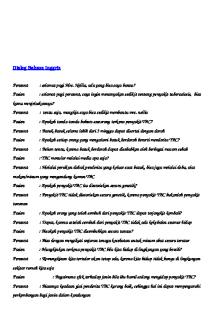
Dialog Bahasa Inggris
- 4 Pages

SKKD BAHASA INGGRIS SMK
- 3 Pages

MAKALAH PEMBELAJARAN BAHASA INGGRIS
- 57 Pages
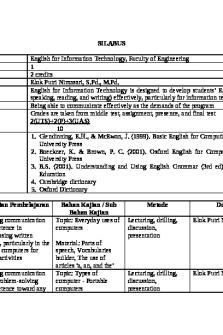
SILABUS BAHASA INGGRIS TI
- 4 Pages
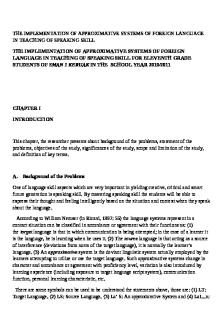
CONTOH SKRIPSI BAHASA INGGRIS
- 24 Pages

CBR bahasa inggris bisnis
- 24 Pages
Popular Institutions
- Tinajero National High School - Annex
- Politeknik Caltex Riau
- Yokohama City University
- SGT University
- University of Al-Qadisiyah
- Divine Word College of Vigan
- Techniek College Rotterdam
- Universidade de Santiago
- Universiti Teknologi MARA Cawangan Johor Kampus Pasir Gudang
- Poltekkes Kemenkes Yogyakarta
- Baguio City National High School
- Colegio san marcos
- preparatoria uno
- Centro de Bachillerato Tecnológico Industrial y de Servicios No. 107
- Dalian Maritime University
- Quang Trung Secondary School
- Colegio Tecnológico en Informática
- Corporación Regional de Educación Superior
- Grupo CEDVA
- Dar Al Uloom University
- Centro de Estudios Preuniversitarios de la Universidad Nacional de Ingeniería
- 上智大学
- Aakash International School, Nuna Majara
- San Felipe Neri Catholic School
- Kang Chiao International School - New Taipei City
- Misamis Occidental National High School
- Institución Educativa Escuela Normal Juan Ladrilleros
- Kolehiyo ng Pantukan
- Batanes State College
- Instituto Continental
- Sekolah Menengah Kejuruan Kesehatan Kaltara (Tarakan)
- Colegio de La Inmaculada Concepcion - Cebu




